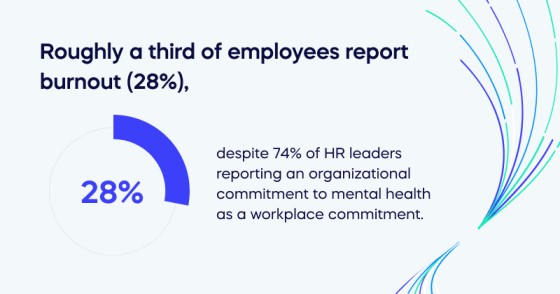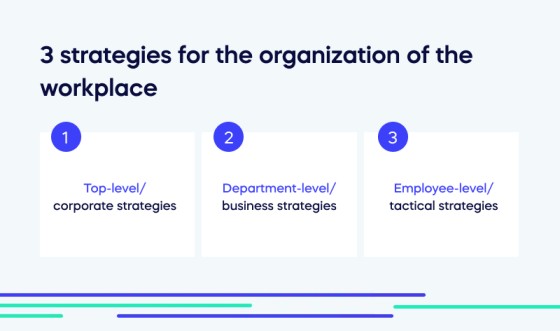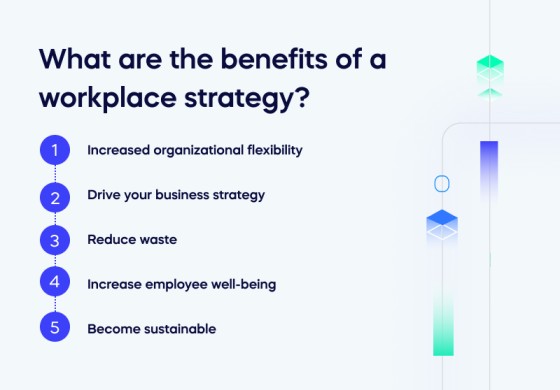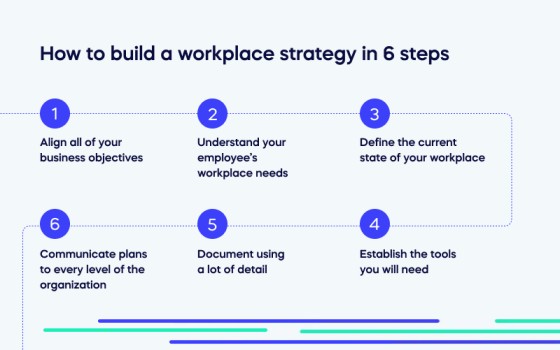How comfortable is your team in their workplace?
This question is crucial to their well-being, productivity, and retention.
Give employees an environment that fits their needs, and they will pay you back with their best efforts to help your organization thrive.
If you implement a weak workplace strategy to reduce costs or avoid this strategy altogether, your team may not remain with you long.
There is a gap between reported attempts to build an employee-focused workplace strategy in the US and the reality.
Roughly a third of employees report burnout (28%), despite 74% of HR leaders reporting an organizational commitment to mental health as a workplace commitment.

To help you understand the importance of an effective workplace strategy, we will explore the following topics:
- What is a workplace strategy?
- 3 strategies for the organization of the workplace
- Why is workplace strategy significant in 2023?
- What are the benefits of a workplace strategy?
- How to build a workplace strategy in 6 steps
What is a workplace strategy?
A workplace strategy helps your company achieve its goals by aligning its processes and work environment.
If you manage multiple workplaces with varying characteristics, don’t worry because there isn’t a one-size-fits-all strategy. Your strategy should reflect your company’s values and business goals, making it unique.
3 strategies for the organization of the workplace

Strategists and workplace consultants typically concentrate on three organizational levels of any workplace strategy program.
Going from the most general to the most specific, these organizational levels for workplace strategies include:
- Top-level/corporate strategies: This involves real estate decisions that can affect one or more facilities.
- Department-level/business strategies: Different department floor plans are affected by workplace design decisions.
- Employee-level/tactical strategies: This concerns flexible working arrangements like activity-based working and other resources that affect staff’s daily lives and productivity based on employee expectations.
Workplace strategies are optimized effectively at each level when technologies provide robust, real-time data.
What are the benefits of a workplace strategy?

Here are five benefits to implementing a workplace strategy.
Increased organizational flexibility
Organizations can save on real estate costs by adopting an occupancy model, a shared working environment that helps manage headcount growth within the existing office space.
A 2023 Workplace Strategy Report shows that a very promising 59% of leaders want employees to build their organization’s culture, making it clear that the intention to allow employees to influence organizational flexibility exists.
The organizational flexibility approach is especially beneficial in the current scenario, where many employees work remotely during the week, leading to an uncertain number of people in the office at any given time.
Drive your business strategy
The strategy may enhance collaboration, eliminate divisions, and attract skilled workers to accomplish all these objectives.
Hiring a workplace strategy consultant can help your workplace drive cultural change that reflects your organization’s vision and values.
A younger workforce is changing workstyles and priorities, prioritizing workplace standards, seeking employers who offer flexibility, choice, connectivity, and learning opportunities, and encouraging innovation beyond the job description.
Reduce waste
One of the primary reasons why an organization may choose to adopt a new way of working is to cut down on expenses.
Collect data on when your staff like to come into the office. If this fits the common trend of Tuesday to Thursday being the most popular days, you may save resources by closing the office on Mondays and Fridays.
Other options include a shared occupancy model, upgrading technology, and giving employees more flexibility and opportunities to provide flexibility for staff while reducing waste for the organization.
Increase employee well-being
You should use employee well-being as a goal to drive your workplace strategy project.
One way for organizations to enhance the employee experience is by altering the physical space. Some examples of these modifications are:
- Provide access to ergonomic environments.
- Promote a connection with nature by incorporating natural light and biophilia (plants).
- Offer a variety of settings that cater to various workstyles and preferences.
- Break-out spaces that are well-appointed are available separate from the business environment.
- Spaces that promote physical activity, such as exercise or yoga rooms.
- Universal bathrooms for all genders and excellent facilities management.
Become sustainable
Take the time to understand how people work best to reduce inefficiencies significantly. One way to do this is to adopt paper-lite practices when transitioning to a new working method, which can help reduce waste.
Also, the flexibility to adjust the number of people working in a designated area can help reduce the overall footprint. Additionally, we could consider factors such as technology’s energy efficiency and lighting when designing the future workspace.
How to build a workplace strategy in 6 steps

Follow these six steps to build a workplace strategy to improve efficiency and employee well-being and facilitate sustainable growth.
1. Align all of your business objectives
Before creating your workplace strategy, it’s important to remember your business’s overall goals. Whether boosting revenue, cutting expenses, or enhancing employee experience, your workplace strategy should align with these objectives.
Do you prioritize employee retention over expanding and cutting back on spending? Use your answers to this question to align your business objectives.
2. Understand your employee’s workplace needs
It’s essential to consider your employees’ preferences and how they want to use their workspace to create an effective workplace strategy.
Survey the company to discover the preferred number of on-site workdays, top amenities, and willingness to participate in new programs. You can also try adding a suggestion section for your employees to share unique ideas.
When you have a clearer understanding of your employees’ work preferences and workspace, you can create a plan for a hybrid work policy.
Doing so will also help you manage the workspace in a way that satisfies your employees as you identify trends in how their expectations change.
3. Define the current state of your workplace
First, evaluating your existing position or current workplace strategy is essential to achieve your workplace goals. Assess your workplace to determine if it aligns with your objectives.
Determine your current position and utilize these critical measures to develop a workplace strategy that works for all your employees.
Smart use of space
Do you provide information on the daily occupancy of the office, including employees, contractors, and visitors?
Additionally, what percentage of your desks and conference rooms are typically in use, and how frequently are they used?
Lastly, can you share the vacant or unused space in the office?
Operational costs for your workplaces
Provide information on the cost per square foot of corporate real estate, cost per employee, and the percentage of total workplace costs about revenue.
Compliance and security
Are you fulfilling all health, privacy, and building access regulations fully complied with at your workplaces?
Employee satisfaction
Do your employees seem happy with the workplace environment and amenities offered? How frequently do you receive reports of maintenance or tech problems in the workplace? And how long does it usually take to resolve these issues?
Employee engagement
Do your employees feel happy and engaged in their workplace? If not, consider how to change this.
Energy efficiency
Can you provide information on the energy consumption of your real estate assets, including the proportion that comes from renewable sources? If you already practice high energy efficiency, include it in your recruitment materials to attract talent.
Revenue of workplaces
How much monthly revenue can you generate from renting to tenants, hosting events, or leasing short-term?
By identifying areas where your organization is doing well or needs improvement, you can provide recommendations on how to enhance your workplace in your workplace strategy.
4. Establish the tools you will need
A well-defined workplace strategy incorporates tools that facilitate communication between employees, their workspaces, and their buildings.
These tools are similar to the ones many companies employ when transitioning to fully remote work, such as Zoom, Slack, and other virtual collaboration tools, to maintain high employee performance via robust connectivity.
List the tools you currently use at work and assess whether they support your new strategy.
Utilizing appropriate tools can help ensure that your strategy is conceptual and make it easier to implement in your workplace.
5. Document using a lot of detail
After completing your research for developing your workplace strategy, the next step is to write down all the goals you intend to achieve with the new plan.
It is essential to be as specific as possible to ensure a smooth transition from the current state (point A) to the desired shape (point B).
A workplace strategy should not just list tactics but clearly outline where you will concentrate your efforts and the reasons behind those decisions.
6. Communicate plans to every level of the organization
It’s essential to involve a team of motivated people to improve it to ensure the success of your strategy.
Begin by sharing your plan with key stakeholders such as executive leadership, workplace managers, IT and HR teams. This action will help you socialize your strategy and garner support for its success.
When executing the strategy, you must share your proposal with stakeholders and executive sponsors for approval. This process will help refine the strategy and ensure it aligns with the business’s objectives based on their feedback and questions.
Lastly, communicate your strategy to the employees most affected by it. You can do this by holding a company-wide meeting or attending team meetings to discuss the future of the workplace and why.
Drive your workplace strategy with employee needs
When planning your long-term approach, it is essential to consider employee needs, preferences, and aspirations to ensure higher productivity and job satisfaction.
An effective workplace strategy encourages collaboration, creativity, and critical thinking, as well as empowering individuals working in physical environments suitable for them.
To highlight the desire for joined-up working, 65% of decision-makers name collaboration as a motivator for their workplace strategy (cited in the report above).
Understanding each decision’s impact will lead to an environment where employees love participating, benefiting all stakeholders.


